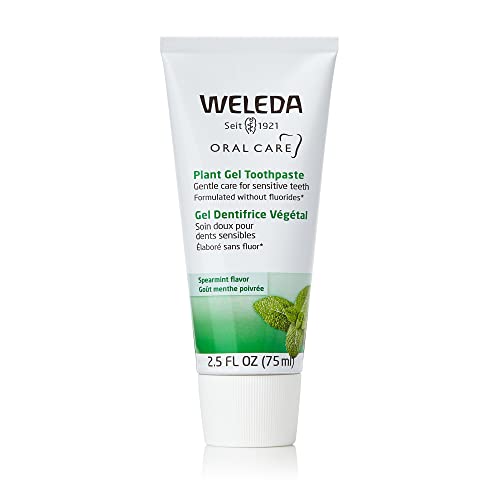

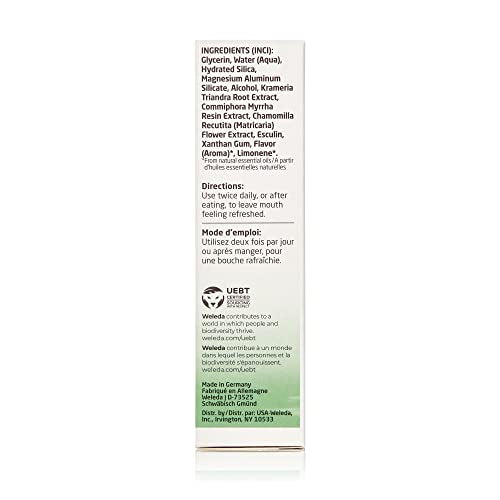
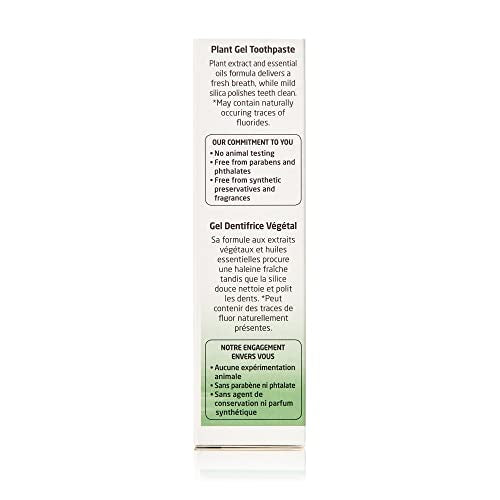
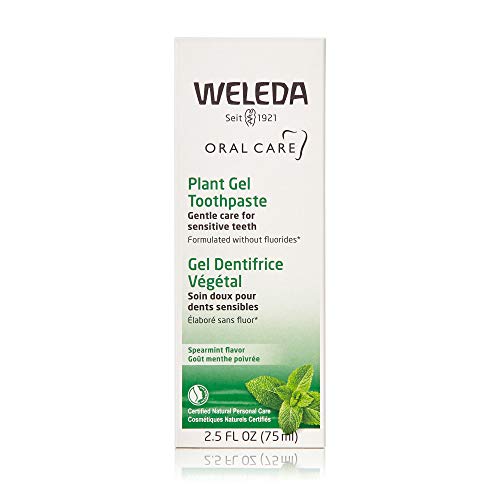
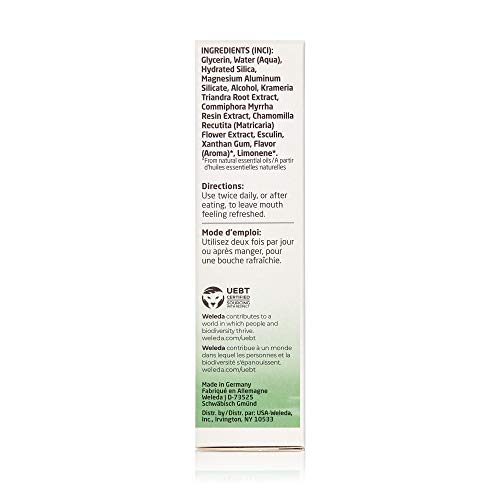

Weleda Plant Gel Toothpaste - Natural Relief for Sensitive Teeth, Mint Flavor - 2.5oz


Microcrystalline Cellulose
Medium RiskMicrocrystalline cellulose is an isolated, colloidal form of cellulose derived from plant sources. It is commonly used as a bulking agent, stabilizer, and texturizer in various food and cosmetic products due to its ability to improve product consistency and enhance texture.
Sustai Insights
Microcrystalline cellulose offers functional benefits such as acting as a bulking agent and stabilizer in formulations. It is generally considered low risk for carcinogenicity and developmental toxicity, with moderate concerns related to allergies. It does not bioaccumulate and poses minimal environmental hazards. Regulatory bodies do not impose significant restrictions on its use. Safe usage practices should be observed, especially in sensitive populations. Alternatives such as plant-based thickeners may provide similar benefits with potentially lower allergic reactions. Overall, the ingredient is assessed as medium risk.
Unspecified Flavor
Medium RiskUnspecified flavor refers to a term used by cosmetic manufacturers to denote a flavoring component in products. This ingredient functions primarily to enhance the sensory experience of the product, providing a pleasant taste or scent without specifying the exact composition of the flavoring agents used.
Sustai Insights
Unspecified flavor serves as an effective sensory enhancer in cosmetic products, adding taste or aroma without revealing specific ingredients. However, it may pose low health risks, including potential allergens or irritants, with no significant carcinogenic or reproductive toxicity concerns. Environmentally, it is not known to be bioaccumulative or a notable pollutant. Regulatory bodies impose minimal restrictions on its use. Given these factors, the overall risk level is assessed as medium, necessitating cautious use and consideration of potential safer alternatives.
Glycerin
Medium RiskGlycerin (also called glycerol) is a naturally occurring compound commonly used in personal care and cosmetic products. It functions as a humectant, attracting moisture to the skin, and is also utilized as a solvent and emollient to enhance product texture and stability.
Sustai Insights
Glycerin is valued for its effective moisturizing properties and biodegradability, making it a widely accepted ingredient in formulations. It poses low health risks, including low concerns for carcinogenicity and allergies. However, moderate use restrictions exist due to regulatory guidelines. While glycerin does not significantly contribute to environmental pollution, its production process should be ethically sourced. Overall, glycerin holds a medium risk level, emphasizing the importance of safe usage practices and considering sustainable alternatives.
Limonene
Medium RiskLimonene is a scent ingredient and solvent naturally found in citrus fruits, commonly used in personal care and cleaning products for its fragrant properties. It serves as a flavoring agent and enhances the overall sensory experience of products.
Sustai Insights
Limonene offers functional benefits such as acting as a solvent and fragrance enhancer. However, it carries a high allergenic potential, which can trigger skin or respiratory sensitivities in some individuals. Environmental concerns include moderate persistence and bioaccumulation, along with potential ecotoxicity. Regulatory restrictions necessitate verification in products containing this ingredient. Overall, the risk level is assessed as medium, emphasizing the importance of cautious use, particularly for sensitive populations. Safer alternatives may be considered to mitigate these risks.
Krameria Triandra (Rhatany) Root Extract
Low RiskKrameria triandra (rhatany) root extract is derived from the roots of the Krameria triandra plant, commonly found in South America. It is primarily used in cosmetic formulations for its astringent and anti-inflammatory properties, contributing to skin soothing and conditioning.
Sustai Insights
Krameria triandra root extract offers functional benefits as a natural astringent and is noted for its low health risk profile, with minimal concerns regarding carcinogenicity, allergies, or reproductive toxicity. Environmentally, it poses low risk as a non-pollutant and non-bioaccumulative ingredient. Regulatory assessments indicate no significant restrictions. Overall, it holds a low-risk status, making it a suitable choice in formulations, although users should practice standard precautions. Alternatives such as witch hazel or green tea extract may offer similar benefits.
Commiphora Myrrha (Myrrh) Resin Extract
Low RiskCommiphora myrrha (myrrh) resin extract is derived from the resin of the myrrh tree. It is commonly used in cosmetics and personal care products for its aromatic properties and potential skin benefits. Myrrh has historical significance in traditional medicine and is recognized for its role in fragrance formulations.
Sustai Insights
Myrrh extract is noted for its functional benefits, including antimicrobial properties and potential skin soothing effects. It is sustainably sourced and biodegradable. Health risks are minimal, with low concerns regarding carcinogenicity, allergies, and reproductive toxicity. Environmental risks are low, with no significant pollutants or bioaccumulation reported. Regulatory status is clear, with no current restrictions. Overall, the risk assessment for myrrh extract indicates a low risk, making it a safe option in product formulations. Safe usage practices should be followed, and alternatives include other natural resins if needed.
Esculin
Low RiskEsculin is a glucoside compound originally obtained from the horse chestnut tree (Aesculus hippocastanum). It is primarily used in cosmetic and personal care formulations for its antioxidant properties and potential skin benefits.
Sustai Insights
Esculin offers functional benefits such as antioxidant activity, which can be advantageous in skin care products. It is not associated with significant health risks, with low concerns regarding carcinogenicity, allergies, or reproductive toxicity. Environmental impact is minimal, and it is not currently restricted by regulatory agencies. Overall, the risk level is low, and safe usage practices are recommended. Alternatives include other plant-based antioxidants, although esculin is already considered a sustainable option.
Chamomilla Recutita (Matricaria) Flower Extract
Low RiskChamomilla recutita (Matricaria) flower extract is derived from the flower of the chamomile plant. It is commonly used in cosmetic products for its soothing properties and as an anti-inflammatory agent. This extract is valued for its potential to calm skin irritations and enhance overall skin appearance.
Sustai Insights
Chamomilla recutita (Matricaria) flower extract is recognized for its soothing and anti-inflammatory benefits, making it effective in skincare formulations. It is sustainably sourced and not associated with significant health risks, such as carcinogenicity or allergenic potential, resulting in a low-risk profile. Environmental concerns are minimal as it does not contribute significantly to pollution. Regulatory bodies impose few restrictions on its use, further supporting its safety. However, users should practice standard safety measures, particularly if they have known sensitivities. Overall, it is a low-risk ingredient with favorable attributes.
Ethanol
Low RiskEthanol, also known as ethyl alcohol, is a volatile, colorless liquid commonly used as a solvent, preservative, and antiseptic in various personal care products. It serves as a penetration enhancer, improving the absorption of other ingredients through the skin.
Sustai Insights
Ethanol functions effectively as a preservative and solvent, offering benefits such as enhanced ingredient absorption and antimicrobial properties. It is biodegradable and can be sustainably sourced. Health risks are minimal, with low concerns for carcinogenicity, allergies, and developmental toxicity. Environmental impacts are also low, with no significant pollutant potential. Regulatory agencies do not impose restrictions on its use. Overall, ethanol is considered low risk, making it a widely accepted ingredient in personal care formulations.
Hydrated Silica
Low RiskHydrated silica is a form of silicon dioxide that appears as a fine, white powder. It is commonly used in cosmetic products for its thickening, anti-caking, and absorbent properties, enhancing product texture and stability.
Sustai Insights
Hydrated silica serves as an effective thickening agent and absorbent, contributing to product stability. It has a low potential for health risks, with minimal concerns regarding carcinogenicity, allergies, or reproductive toxicity. Environmental risks are also low, with no significant bioaccumulation or pollution concerns. Regulatory bodies do not impose major restrictions, classifying it as low-risk overall. For safe usage, it is recommended to follow product instructions. Alternatives include more natural thickeners like xanthan gum for sustainable formulations.
Water
Low RiskWater is a clear, colorless liquid essential for various biological processes. It serves as a solvent in formulations, facilitating the dissolution of other ingredients and enhancing product texture and application. Additionally, water plays a crucial role in hydration and is a key component in many cosmetic and personal care products.
Sustai Insights
Water is an effective solvent and hydrator, contributing to the texture and efficacy of formulations. It is biodegradable and generally regarded as safe, with low concerns regarding carcinogenicity, allergies, and reproductive toxicity. However, excessive water usage can lead to environmental concerns, particularly regarding resource depletion. Regulatory bodies do not impose restrictions on water use in cosmetics. Overall, the risks associated with water are low, making it a safe and essential ingredient.
Xanthan Gum
Low RiskXanthan gum is a polysaccharide, a sugar-based compound produced by the fermentation of glucose or sucrose. It is commonly used as a thickening agent and stabilizer in various food and cosmetic products due to its ability to improve texture and prevent ingredient separation.
Sustai Insights
Xanthan gum serves effectively as a thickener and stabilizer, enhancing product texture and consistency. It is biodegradable and typically derived from renewable sources, supporting sustainability efforts. Health risks are minimal, with low concerns regarding carcinogenicity, allergies, and reproductive toxicity. Environmental impact is similarly low, posing no significant hazards. Regulatory agencies, including the FDA, regard it as safe for use, with no significant restrictions. Overall, xanthan gum is assessed as low risk, making it a suitable ingredient in formulations.
Microcrystalline Cellulose
Medium RiskMicrocrystalline cellulose is an isolated, colloidal form of cellulose derived from plant sources. It is commonly used as a bulking agent, stabilizer, and texturizer in various food and cosmetic products due to its ability to improve product consistency and enhance texture.
Sustai Insights
Microcrystalline cellulose offers functional benefits such as acting as a bulking agent and stabilizer in formulations. It is generally considered low risk for carcinogenicity and developmental toxicity, with moderate concerns related to allergies. It does not bioaccumulate and poses minimal environmental hazards. Regulatory bodies do not impose significant restrictions on its use. Safe usage practices should be observed, especially in sensitive populations. Alternatives such as plant-based thickeners may provide similar benefits with potentially lower allergic reactions. Overall, the ingredient is assessed as medium risk.
Unspecified Flavor
Medium RiskUnspecified flavor refers to a term used by cosmetic manufacturers to denote a flavoring component in products. This ingredient functions primarily to enhance the sensory experience of the product, providing a pleasant taste or scent without specifying the exact composition of the flavoring agents used.
Sustai Insights
Unspecified flavor serves as an effective sensory enhancer in cosmetic products, adding taste or aroma without revealing specific ingredients. However, it may pose low health risks, including potential allergens or irritants, with no significant carcinogenic or reproductive toxicity concerns. Environmentally, it is not known to be bioaccumulative or a notable pollutant. Regulatory bodies impose minimal restrictions on its use. Given these factors, the overall risk level is assessed as medium, necessitating cautious use and consideration of potential safer alternatives.
Krameria Triandra (Rhatany) Root Extract
Low RiskKrameria triandra (rhatany) root extract is derived from the roots of the Krameria triandra plant, commonly found in South America. It is primarily used in cosmetic formulations for its astringent and anti-inflammatory properties, contributing to skin soothing and conditioning.
Sustai Insights
Krameria triandra root extract offers functional benefits as a natural astringent and is noted for its low health risk profile, with minimal concerns regarding carcinogenicity, allergies, or reproductive toxicity. Environmentally, it poses low risk as a non-pollutant and non-bioaccumulative ingredient. Regulatory assessments indicate no significant restrictions. Overall, it holds a low-risk status, making it a suitable choice in formulations, although users should practice standard precautions. Alternatives such as witch hazel or green tea extract may offer similar benefits.
Commiphora Myrrha (Myrrh) Resin Extract
Low RiskCommiphora myrrha (myrrh) resin extract is derived from the resin of the myrrh tree. It is commonly used in cosmetics and personal care products for its aromatic properties and potential skin benefits. Myrrh has historical significance in traditional medicine and is recognized for its role in fragrance formulations.
Sustai Insights
Myrrh extract is noted for its functional benefits, including antimicrobial properties and potential skin soothing effects. It is sustainably sourced and biodegradable. Health risks are minimal, with low concerns regarding carcinogenicity, allergies, and reproductive toxicity. Environmental risks are low, with no significant pollutants or bioaccumulation reported. Regulatory status is clear, with no current restrictions. Overall, the risk assessment for myrrh extract indicates a low risk, making it a safe option in product formulations. Safe usage practices should be followed, and alternatives include other natural resins if needed.
Esculin
Low RiskEsculin is a glucoside compound originally obtained from the horse chestnut tree (Aesculus hippocastanum). It is primarily used in cosmetic and personal care formulations for its antioxidant properties and potential skin benefits.
Sustai Insights
Esculin offers functional benefits such as antioxidant activity, which can be advantageous in skin care products. It is not associated with significant health risks, with low concerns regarding carcinogenicity, allergies, or reproductive toxicity. Environmental impact is minimal, and it is not currently restricted by regulatory agencies. Overall, the risk level is low, and safe usage practices are recommended. Alternatives include other plant-based antioxidants, although esculin is already considered a sustainable option.
Chamomilla Recutita (Matricaria) Flower Extract
Low RiskChamomilla recutita (Matricaria) flower extract is derived from the flower of the chamomile plant. It is commonly used in cosmetic products for its soothing properties and as an anti-inflammatory agent. This extract is valued for its potential to calm skin irritations and enhance overall skin appearance.
Sustai Insights
Chamomilla recutita (Matricaria) flower extract is recognized for its soothing and anti-inflammatory benefits, making it effective in skincare formulations. It is sustainably sourced and not associated with significant health risks, such as carcinogenicity or allergenic potential, resulting in a low-risk profile. Environmental concerns are minimal as it does not contribute significantly to pollution. Regulatory bodies impose few restrictions on its use, further supporting its safety. However, users should practice standard safety measures, particularly if they have known sensitivities. Overall, it is a low-risk ingredient with favorable attributes.
Ethanol
Low RiskEthanol, also known as ethyl alcohol, is a volatile, colorless liquid commonly used as a solvent, preservative, and antiseptic in various personal care products. It serves as a penetration enhancer, improving the absorption of other ingredients through the skin.
Sustai Insights
Ethanol functions effectively as a preservative and solvent, offering benefits such as enhanced ingredient absorption and antimicrobial properties. It is biodegradable and can be sustainably sourced. Health risks are minimal, with low concerns for carcinogenicity, allergies, and developmental toxicity. Environmental impacts are also low, with no significant pollutant potential. Regulatory agencies do not impose restrictions on its use. Overall, ethanol is considered low risk, making it a widely accepted ingredient in personal care formulations.
Hydrated Silica
Low RiskHydrated silica is a form of silicon dioxide that appears as a fine, white powder. It is commonly used in cosmetic products for its thickening, anti-caking, and absorbent properties, enhancing product texture and stability.
Sustai Insights
Hydrated silica serves as an effective thickening agent and absorbent, contributing to product stability. It has a low potential for health risks, with minimal concerns regarding carcinogenicity, allergies, or reproductive toxicity. Environmental risks are also low, with no significant bioaccumulation or pollution concerns. Regulatory bodies do not impose major restrictions, classifying it as low-risk overall. For safe usage, it is recommended to follow product instructions. Alternatives include more natural thickeners like xanthan gum for sustainable formulations.
Water
Low RiskWater is a clear, colorless liquid essential for various biological processes. It serves as a solvent in formulations, facilitating the dissolution of other ingredients and enhancing product texture and application. Additionally, water plays a crucial role in hydration and is a key component in many cosmetic and personal care products.
Sustai Insights
Water is an effective solvent and hydrator, contributing to the texture and efficacy of formulations. It is biodegradable and generally regarded as safe, with low concerns regarding carcinogenicity, allergies, and reproductive toxicity. However, excessive water usage can lead to environmental concerns, particularly regarding resource depletion. Regulatory bodies do not impose restrictions on water use in cosmetics. Overall, the risks associated with water are low, making it a safe and essential ingredient.
Glycerin
Medium RiskGlycerin (also called glycerol) is a naturally occurring compound commonly used in personal care and cosmetic products. It functions as a humectant, attracting moisture to the skin, and is also utilized as a solvent and emollient to enhance product texture and stability.
Sustai Insights
Glycerin is valued for its effective moisturizing properties and biodegradability, making it a widely accepted ingredient in formulations. It poses low health risks, including low concerns for carcinogenicity and allergies. However, moderate use restrictions exist due to regulatory guidelines. While glycerin does not significantly contribute to environmental pollution, its production process should be ethically sourced. Overall, glycerin holds a medium risk level, emphasizing the importance of safe usage practices and considering sustainable alternatives.
Limonene
Medium RiskLimonene is a scent ingredient and solvent naturally found in citrus fruits, commonly used in personal care and cleaning products for its fragrant properties. It serves as a flavoring agent and enhances the overall sensory experience of products.
Sustai Insights
Limonene offers functional benefits such as acting as a solvent and fragrance enhancer. However, it carries a high allergenic potential, which can trigger skin or respiratory sensitivities in some individuals. Environmental concerns include moderate persistence and bioaccumulation, along with potential ecotoxicity. Regulatory restrictions necessitate verification in products containing this ingredient. Overall, the risk level is assessed as medium, emphasizing the importance of cautious use, particularly for sensitive populations. Safer alternatives may be considered to mitigate these risks.
Xanthan Gum
Low RiskXanthan gum is a polysaccharide, a sugar-based compound produced by the fermentation of glucose or sucrose. It is commonly used as a thickening agent and stabilizer in various food and cosmetic products due to its ability to improve texture and prevent ingredient separation.
Sustai Insights
Xanthan gum serves effectively as a thickener and stabilizer, enhancing product texture and consistency. It is biodegradable and typically derived from renewable sources, supporting sustainability efforts. Health risks are minimal, with low concerns regarding carcinogenicity, allergies, and reproductive toxicity. Environmental impact is similarly low, posing no significant hazards. Regulatory agencies, including the FDA, regard it as safe for use, with no significant restrictions. Overall, xanthan gum is assessed as low risk, making it a suitable ingredient in formulations.
Discover the Weleda Plant Gel Toothpaste, a certified natural toothpaste designed for sensitive teeth and gums, offering effective cleaning without harmful ingredients. This 2.5-ounce gel is your eco-friendly choice for oral care.
- Gentle Cleaning for Sensitive Teeth: Specially formulated to ease sensitivities and inflammation, ensuring a comfortable brushing experience.
- Certified Natural Ingredients: Free from sugar, artificial sweeteners, surfactants, synthetic preservatives, and colorants, making it a healthy, trustworthy option.
- Refreshing Mint Flavor: Enjoy a fresh burst of mint that leaves your mouth feeling clean and revitalized after each use.
- Sustainable Oral Care: Embrace a toothpaste that prioritizes your health and the environment, with ingredients sourced responsibly.
- Easy Application: Simple usage instructions ensure you can maintain a refreshing oral care routine, ideally twice a day for best results.
Subscribe & Save with Sustai
- Best Price Guarantee: Always enjoy the lowest prices on sustainable home essentials.
- No Surprises: We’ll notify you before shipping. No hidden fees, ever.
- You’re in Charge: Change, pause, or cancel your subscription anytime with ease.
- Eco-Friendly Deliveries: Our grouped shipments mean less packaging and lower emissions.
Join us on a sustainable journey. Special offers for a limited time! Prices and promotions may change.
Recommended Products
Discover the Weleda Plant Gel Toothpaste, a certified natural toothpaste designed for sensitive teeth and gums, offering effective cleaning without harmful ingredients. This 2.5-ounce gel is your eco-friendly choice for oral care.
- Gentle Cleaning for Sensitive Teeth: Specially formulated to ease sensitivities and inflammation, ensuring a comfortable brushing experience.
- Certified Natural Ingredients: Free from sugar, artificial sweeteners, surfactants, synthetic preservatives, and colorants, making it a healthy, trustworthy option.
- Refreshing Mint Flavor: Enjoy a fresh burst of mint that leaves your mouth feeling clean and revitalized after each use.
- Sustainable Oral Care: Embrace a toothpaste that prioritizes your health and the environment, with ingredients sourced responsibly.
- Easy Application: Simple usage instructions ensure you can maintain a refreshing oral care routine, ideally twice a day for best results.

You can have at most 2 Sustainable Steals products in your cart
Customer Reviews
Customers’ View
Customers appreciate the refreshing taste and gentle formulation of the Gel Toothpaste, noting its effectiveness for sensitive teeth and gums. Many reviews highlight the pleasant, mild flavor and the absence of artificial ingredients, making it a safer choice for health-conscious consumers. Users frequently mention the whitening effect, stating that their teeth feel clean and their breath remains fresh throughout the day. Additionally, the product's natural ingredients resonate well with environmentally conscious buyers, as it contains no harmful additives like sugars or synthetic preservatives. However, there are some mixed opinions regarding the sulfate content, with a few customers expressing concerns. Overall, this toothpaste aligns well with the values of those seeking effective and eco-friendly oral care solutions.
AI-generated from the text of customer reviewsThis product is rated 4.7 of 5.0 stars.
It has received 15 reviews.





